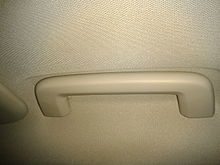Grab handle (vehicle)

Handles in vehicles (especially in public transport) are used to maintain or improve the safe standing or sitting position or safe movement in a moving vehicle.
Handholds must be available and arranged in sufficient numbers in or on the vehicle for this purpose and for the loads that occur.
Execution / quality
Handrails as tour guide elements in vehicles can be vertical bars or railings (handrails).
Handholds must be designed and arranged in such a way that they can also be used by the persons being transported ( adults , children ). Handles placed on the ceiling must be at a height of 800 mm to 1100 mm (adults maximum 1900 mm) for the transport of children. Holding loops are to be provided for every standing room and must have a minimum handle length of 80 mm. For Germany, see also: Annex X to Section 35e Paragraph 4, Section 35f, Section 35i) StVZO.
Vertical bars and railings / handrails are usually made of metal (mostly steel ) and coated (sometimes in signal colors at particularly critical points ).
Private transport
Passenger cars
In passenger cars, there are handles by the doors ( A-pillar ) or above the doors ( headliner ) as entry and exit aids.
Trucks
In trucks , entry and exit handles (mostly vertically mounted tubes) are necessary devices to get in and out of the driver's cab safely.
motorcycle
There are handles (passenger handle, pillion handle) on the motorcycle
- right and / or left at the rear end or
- across the end of the bench (behind the passenger).
This enables the front passenger (pillion rider) to assume a stable position on the motorcycle (among other things, it reduces the swaying of the passenger's body). The grab handle also reduces the possibility of the passenger falling when accelerating or braking. This also makes the motorcycle easier to steer.
There can also be a retaining strap / bar (pillion belt, pillion bar) between the people being transported.
See also: motorcycle saddle
Boats / ships
In the case of larger boats or ships , the railing basically fulfills the function of a handle or handrail. In addition, other special handles can also be attached or retrofitted (e.g. in inflatable boats).
See also:
- Handle on the swivel boom
- No grab handles as a special traffic safety obligation in the cabin (Rostock District Court in Az .: 47 C 406/11).
Norms
- DIRECTIVE 2001/85 / EC OF THE EUROPEAN PARLIAMENT AND OF THE COUNCIL of November 20, 2001 on special regulations for vehicles for the transport of passengers. (PDF)
- Administrative regulation: Guideline for the assessment of standing room in buses (OmnibusStehplBeurtRL), Beuth Verlag 1984.
Web links
- Subway grab bars send advertisements to cell phones , a Japanese pilot project uses NFC - the website loads when touched (online press release 2012).
See also
Individual evidence
- ↑ Railings as fall protection in vehicles are rarely found.
- ↑ See z. B. basic: Appendix I, no. 7.11.2. DIRECTIVE 2001/85 / EC OF THE EUROPEAN PARLIAMENT AND OF THE COUNCIL of November 20, 2001 on special regulations for vehicles for the transport of people with more than eight seats in addition to the driver's seat and amending Directives 70/156 / EEC and 97/27 / EC ( OJ L 42 of 13 February 2002, p. 1).
- ↑ Appendix I, No. 7.11.2.2. DIRECTIVE 2001/85 / EC OF THE EUROPEAN PARLIAMENT AND OF THE COUNCIL of 20 November 2001 on special regulations for vehicles for the transport of people with more than eight seats in addition to the driver's seat and amending Directives 70/156 / EEC and 97/27 / EC (OJ . L 42 of February 13, 2002, p. 1). For the test equipment in buses and coaches, see Annex III Figure 20 of the aforementioned guideline.
- ^ For Germany: Announcement of the Federal Ministry of Transport of May 3, 1996; Ref .: StV13 / StV 17 / 36.38.02 [announced in VkBl. 1996 p. 238]; July 14, 2005; Ref .: S 33 / S 37 / S 02 / 36.38.02 [announced in VkBl. 2005 p. 604] - Catalog of requirements for buses and minibuses, which are particularly used for the transport of schoolchildren and kindergarten children - Leaflet for the training of vehicle drivers.
- ↑ Link to judgment 47 C 406/11





